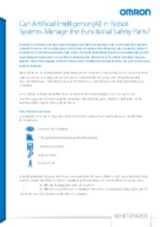Can Artificial Intelligence (AI) in robot systems manage the functional safety parts?
Published on 20 March 2023 in AI
Authors: Josep Plassa, Safety Product Marketing Manager at OMRON Europe and Atsushi Oshiro, Manager at the OMRON Development Center
Robots and AI systems have become an integral part of industrial manufacturing sites. To ensure the safety of workers while using robots, a detailed risk assessment is necessary. This assessment is carried out from the perspective of Functional Safety, which examines the five main elements employed by robots to determine autonomous control actions: Environment recognition, Action planning, Trajectory generation, Motion control, and Measurement.

Issues with AI and Functional Safety
Functional Safety evaluation of robots with embedded AI systems has revealed two significant issues: the difficulty of judging the states of AI systems and differences in performance evaluation metrics between Functional Safety and AI systems.
Determining the state of AI systems can be challenging, particularly for neuronal networks with a complex architecture of nodes or layers. The difficulty lies in diagnosing judgment results, making it impossible to judge the normality of the system. For example, stochastic decisions are made when AI systems fail, which means that such a system cannot be treated as a deterministic system, thus making it challenging to evaluate it as part of the Safety-Related Parts of the Control System of Functional Safety.
Performance evaluation metrics for AI include accuracy, precision, recall, and specificity. However, AI depends on learning data that does not take time series variations into account. Consequently, the error probability of AI systems changes from time to time, making it challenging to evaluate their performance from the perspective of Functional Safety, which evaluates the failure probability during on-site operation as constant.
The examination of the above issues highlights the fact that evaluating the safety of AI systems is not an easy task. Thus, improving the advantages of production systems that use collaborative robots and AI should be restricted to limited areas.
Conclusion
In conclusion, while robots and AI systems offer many benefits to industrial manufacturing sites, the safety of workers is of paramount importance. Therefore, a detailed risk assessment from the perspective of Functional Safety is necessary. However, the evaluation of AI systems' safety performance is challenging, making it necessary to restrict the use of robots with embedded AI in specific areas. The examination of these issues calls for innovative solutions to improve the safety of robots with embedded AI systems.
Contact us for more information
